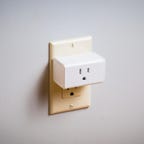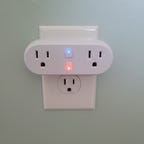Wish You Could Schedule Your Living Room Lamp? These Smart Plugs Can Help

Best smart plug overall
Leviton D215P-2RW
View details

Another solid smart plug choice
TP-Link Kasa Smart Wi-Fi Plug Mini
View details

Simple setup, best app
GE Cync Smart Plug
View details

Best dual outlet smart plug
HBN Smart Plug
View details
If you’re ready to invest in smart devices and want to start small, consider getting your hands on smart plugs. Instead of buying new TVs, speakers, lightbulbs, coffee makers and more, smart plugs can allow you to control multiple devices and appliances at once. These come in a lot of shapes with several different features, and we found the best smart plugs for every household need.
The best smart plugs will virtually give anything you plug in — lamps, fans, decorative lighting, night lights and so on — the “smart” treatment by controlling the power to said device. They’re similar to upside-down outlets you can turn on or off from a wall switch. Instead of manually flipping a switch, you use your phone, voice or a preset schedule to control the flow of power.
Read more: Want to Buy a Smart Plug? Read This First
What is the best smart plug overall?
Some smart plugs come with added features, such as energy monitoring or IFTTT capabilities. For the most part, your smart plug’s role is to simplify the control of power to whatever you’ve got plugged in. Although smart plugs serve the same basic purpose, not all of them are the same. Pricing, functionality and compatibility with home assistants like Alexa, Google and HomeKit will vary by device.
CNET has tested more than a few smart plugs over the years. In this most recent round, I tested 10 or so in addition to those we’ve previously checked out.
Read more: These Smart Plugs Are the Secret to a Seamless Smart Home
Best smart plugs of 2024
I liked the Leviton D215P-2RW smart plug right out of the box. For a smart plug, it has a sleek design. I’m particularly fond of the little corner window that acts as a button to manually turn the device on and off and as an indicator light — features that most smart plugs keep separated. It’s also slimmer than most smart plugs I’ve seen, which is nice if you’re working with a limited space.
Design aside, I found the Leviton smart plug easy to set up, and the app is pleasantly simple. The home screen displays all connected plugs (or other Leviton smart devices) and their status, along with the ability to switch them on or off with a tap. Setting a schedule for the plug was also easy and intuitive.
Another standout feature of the Leviton smart plug: it plays nice with all three of the major smart home ecosystems. I had no problem connecting the smart plug to my Google Home Mini, but I did have to download the Leviton “skill” to connect to Alexa. It’s an extra step, but one that only took about 30 seconds.
Leviton is also compatible with Apple HomeKit (I connected via an iPad, but Homepods and Apple TV devices will do the job better), which is unique for a smart plug, as the majority of them only work with Alexa and Google. Although that may be changing thanks to Matter, the new universal smart home standard.
We’ve tested the TP-Link Kasa Smart Wi-Fi Plug Mini before and, prior to trying out the Leviton smart plug, it was our pick for best overall. It’s still a great plug with a small, space-saving design, but it lacks the appeal and compatibility to continue its reign as “best overall.”
This smart device works with Google Assistant and Amazon Alexa via your Wi-Fi network, and the Kasa app (Android and iOS) offers plenty of detailed options for customizing scheduling, away modes and timers.
What you won’t get? This Wi-Fi smart plug doesn’t offer energy-consumption data, a USB port or HomeKit compatibility. To be fair, most smart plugs can’t do all that, either, so don’t let that turn you away from this one unless you really need those features. If you’re interested in scheduling and using voice control and voice commands, TP-Link’s smart plug is a great choice to control a light switch or other connected device.
Speaking of apps, GE’s Cync app is nothing short of delightful. The initial smart plug setup took me through a series of simple, step-by-step instructions complemented by soft, home-inspired imagery in the background. The setup also prompted me to connect to Alexa and Google devices, something I had to navigate to within the app or go to a hub to do with other smart plugs.
Once your smart plug is set up, you can control on/off settings from the home screen or tap “Routines” to set a schedule. There are a number of other functions and settings you can play with, such as grouping devices together for simultaneous control or creating “scenes” with custom settings, like turning off a set of lights before starting a movie or changing the smart light bulbs to your team’s color on game day.
If it sounds complicated, you can get a user-friendly, eye-pleasing breakdown of how to use all the various Cync features under Settings > App Tutorials.
I’m getting away from the smart plug a bit, but that’s because the GE Cync app is clearly intended to incorporate multiple devices and support total home automation. You can use the smart plug on its own, but the app invites you to do much more.
Two for the price of one here. The HBN smart plug is one of the few I’ve seen with two independently controlled outlets. Even with the extra outlet, the smart plug isn’t that much wider than other single plugs, and it’s still compact enough to plug something else in above or below it.
I’m sure there are quite a few uses for a dual smart plug, but plugging my Christmas tree lights into one and a corner lamp into the other immediately comes to mind. Currently, I have a light fixture and a fan plugged in and the ability to independently control one or the other is pretty nifty.
The HBN app reminds me of the Leviton app in its user-friendly simplicity. I can turn either switch on or off from the app or by voice command via Alexa or Google. Each outlet is nameable, so you can turn off a single outlet by saying “Alexa, turn off Switch 2,” or control both outlets at once by referring to the device name.
You can also create separate schedules for each outlet. Here at home, I’ve set my fan to come on during these sweltering Southern summer days while the lamp is programmed to come on at night. Again, pretty nifty.
The Emporia smart plug comes with much of the same functionality as other smart plugs — instant on/off control, scheduling, Alexa and Google compatibility — not to mention the rounded edges that made the device feel a bit less bulky than others. What stood out most to me was the app’s focus on energy monitoring.
From the home screen display, you can see connected devices and their on/off status along with how much energy they are currently using. Tapping the plug or power icons will take you to the on/off settings, or you can tap on the device name to see a graph of your plug’s (that is, whatever’s plugged into it) energy use over time.
The Management screen lets you prioritize Emporia devices to automatically turn off if you approach a set peak energy demand goal, automatically consume excess solar energy and create a custom schedule. There are other energy monitoring and consumption features, but that’s the gist of it.
Emporia’s app is certainly useful and informative, but speaking strictly from a standalone smart plug standpoint, it can get mildly in the way of actually using the smart plug. I had to play with it a bit to figure out that “Management > Time-of-use management” was the means to create a schedule, and turning the plug on and off from the Home screen wasn’t set as a default.
There’s also the consideration of whether or not the thing you’ve got plugged into your Emporia smart plug is worth the in-depth monitoring. Most smart plug applications are for lamps, nightlights, fans and other fixtures that are relatively low on the energy consumption scale. Still, if you want a smart plug that monitors your energy use and allows for more energy-efficient customization than other plugs, this is the one for you.
There are dozens of smart plugs out there from companies large and small, and while we haven’t tested every single one, we’ve tried out many of the ones you’d come across online or at your local big box store. Here’s a quick look at other notable options. All are compatible with Alexa and Google (excluding the Amazon Smart Plug), but not HomeKit unless specifically noted. Again, Matter could change that compatibility in the future.
- Amazon Smart Plug: A flagship for the brand, the Amazon smart plug costs $25 and only works with Amazon Alexa. While the set-up is easy, it isn’t as feature-rich as other models, which may be a deal-breaker when you’re looking for a smart outlet.
- ConnectSense Smart Outlet 2: This smart plug does it all — energy monitoring, individually controlled outlets, a USB port and LED status lighting. The unattractive, oversized design is enough to keep us from recommending it. Everyone loves a smart outlet, but no one likes an ugly one.
- Enbrighten Dual Smart Plug: Like with the HBN smart plug, I appreciated the extra outlet. The Enbrighten version is significantly wider and doesn’t allow for individual control of each outlet, at least not in any way that I could easily figure out. It’s also priced a bit higher than the HBN dual outlet at $22.
- Govee Smart Wi-Fi Plug: The round design is nice and blends in with my wall plate perfectly while leaving plenty of room for another plug. Nothing else really stands out about the plug, unfortunately, but if you want a simple, cheap (currently $8) plug that doesn’t scream “I’m a smart plug,” this is a good choice.
- Philips Hue Smart Plug: The Philips Hue app reminded me of GE’s Cync app in that the setup was simple and there’s the potential to connect multiple devices under whole-home automation. For a single smart plug, this one is fairly expensive at $35, and it doesn’t sport any unique features to justify the cost.
- Wyze: We like the Wyze Smart Plug primarily for its low pricing. The Wyze does all the basic functions of a smart plug and will only set you back $18 for a two-pack. The bargain price is nice, but if you only need one plug, there are cheaper options.
- Vont Smart Plug [Out of Stock]: Your standard smart plug. Nothing special, but nothing that would turn me away from using it, either. If you can catch it on sale, or perhaps in a value-priced two-pack, this smart plug can be a decent, budget-friendly addition to your smart home.
- WeMo [Out of Stock]: We previously featured this smart plug as “Best for HomeKit” in spite of other shortcomings like a less-than-impressive app. Yes, the smart plug works well with a HomeKit setup along with Alexa and Google, but so does the more user-friendly Leviton plug.
Show more
Which smart plug should I buy?
Do smart plugs save energy?
Source: CNET














